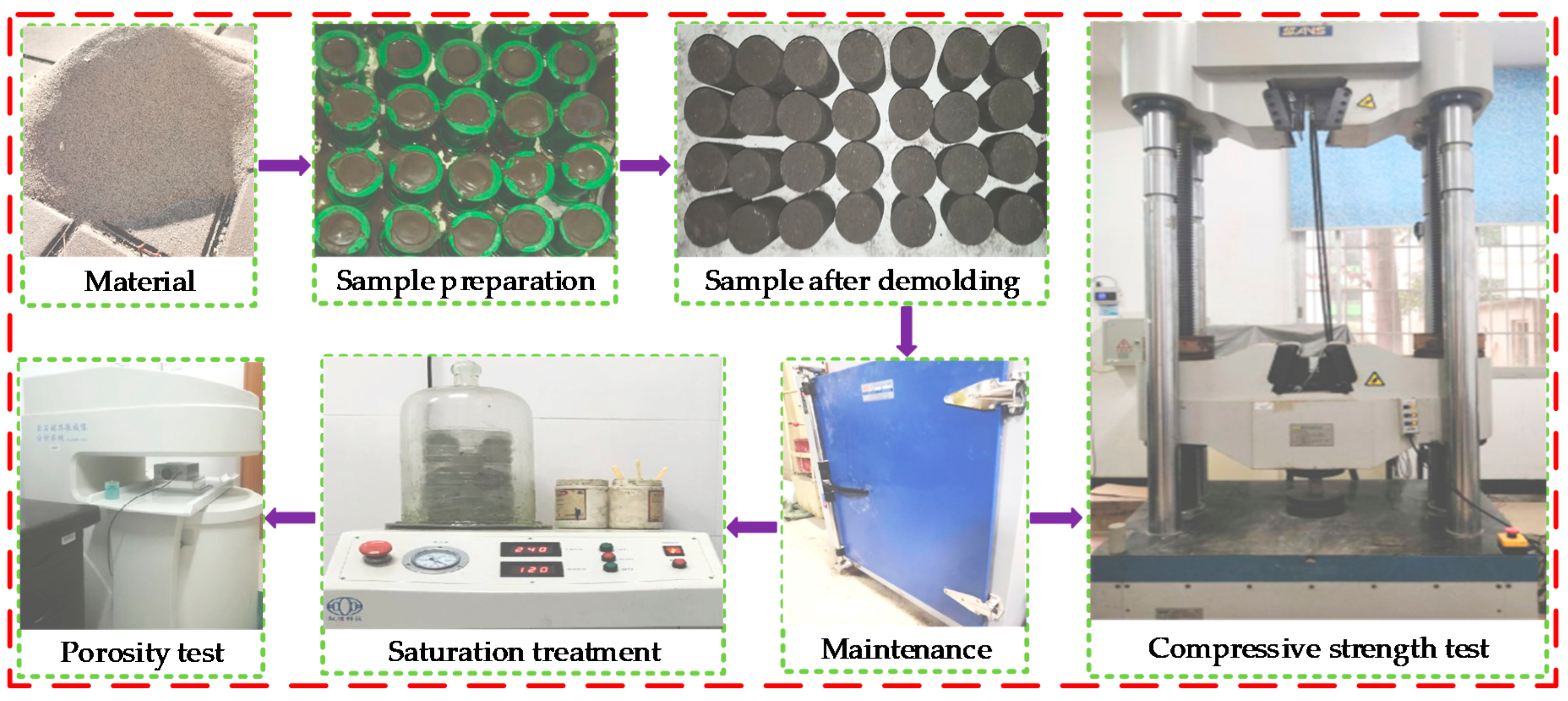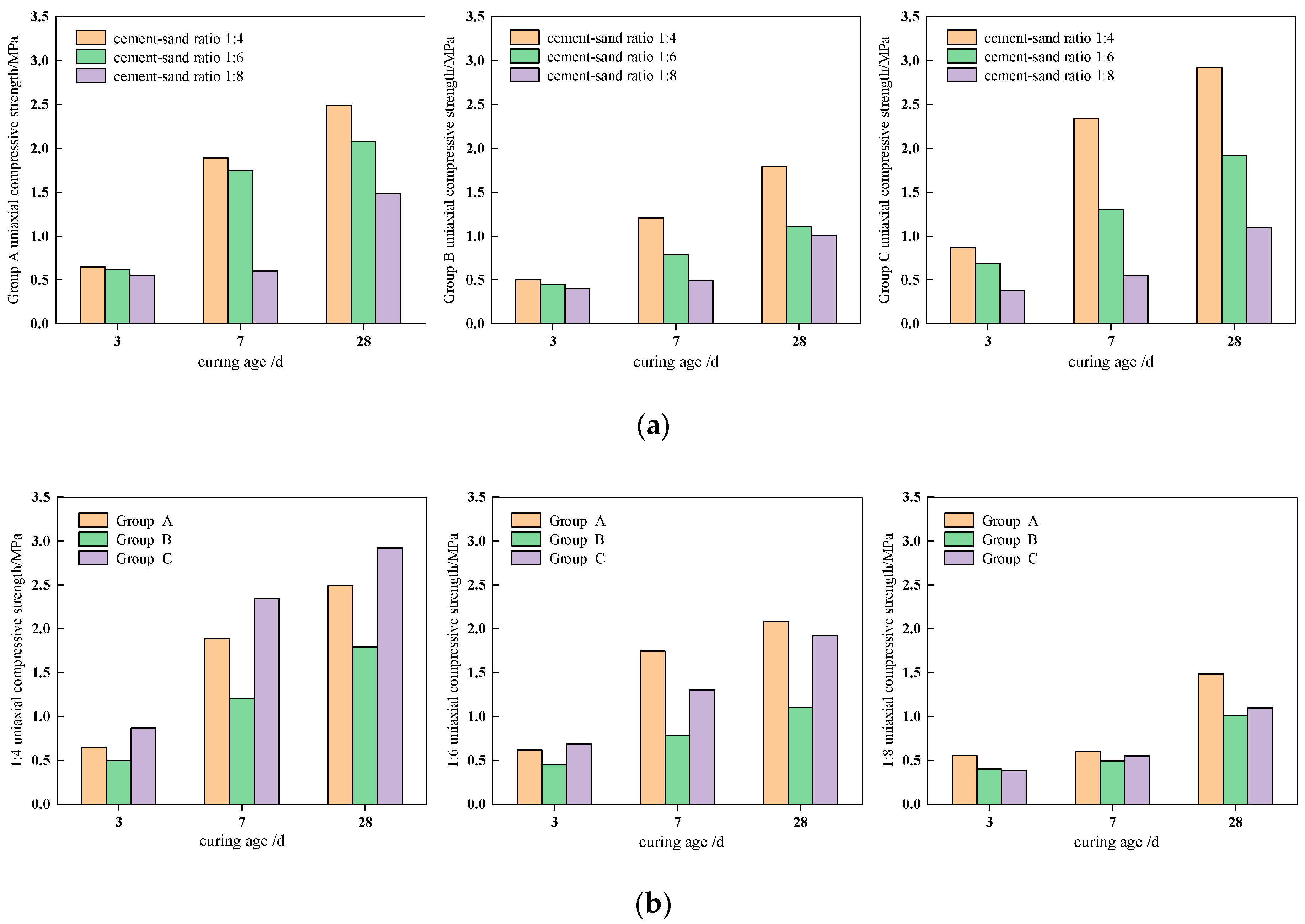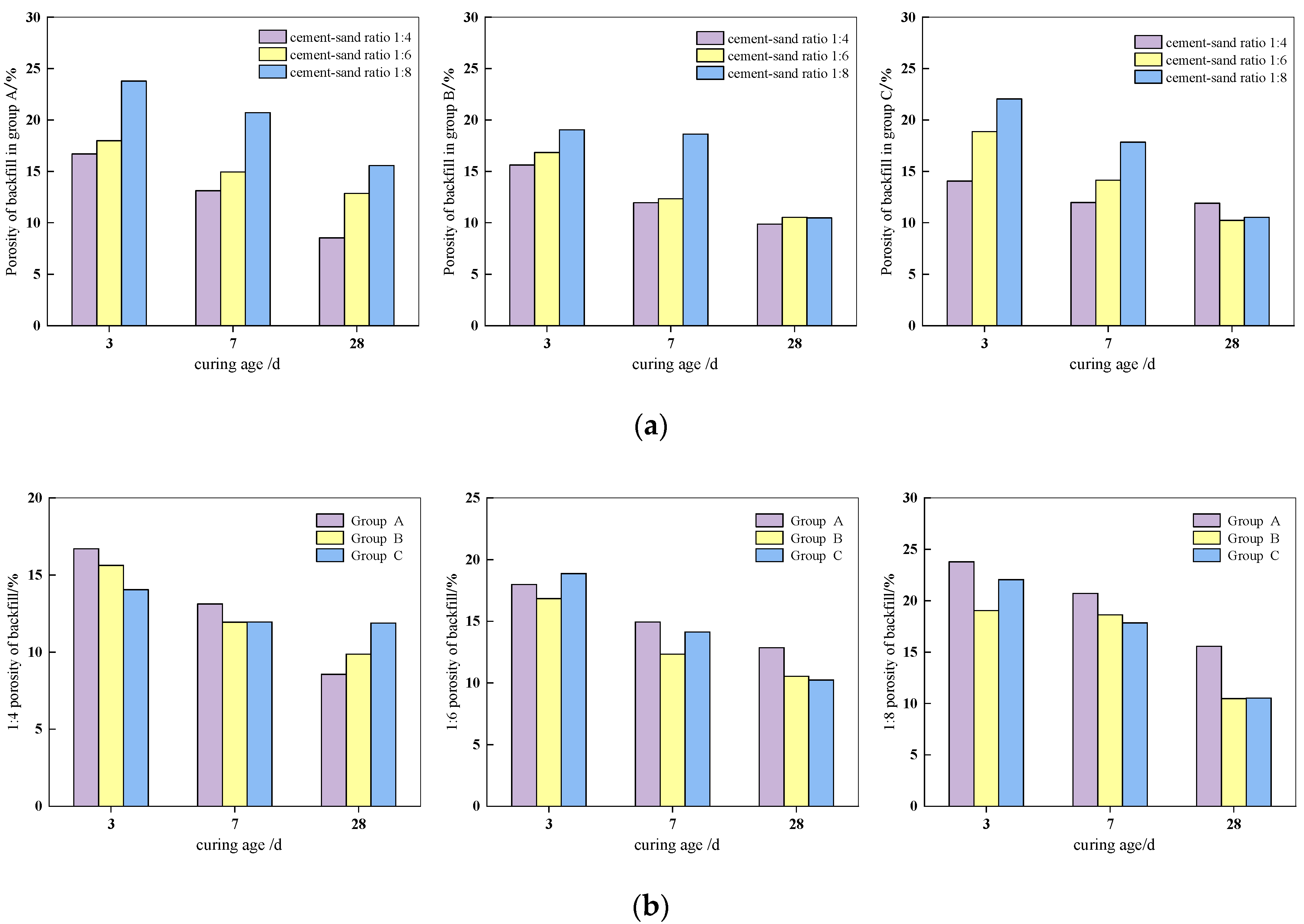Study on the Strength Evolution Characteristics of Cemented Tailings Backfill from the Perspective of Porosity
Abstract
1. Introduction
2. Materials and Methods
2.1. Experiment Materials
2.2. Sample Preparation
- (1)
- Mold cleaning. Take out the mold and clean it, and apply a layer of lubricating oil on the inside to facilitate later demolding.
- (2)
- Raw material weighing. According to the design of the test plan, weigh the amount of tailings, cement, additives and tap water solution needed for the test.
- (3)
- Stir to fill the mold. Mix the measured raw materials thoroughly for 5 min, and then fill the prepared mold with a glass rod.
- (4)
- Stripping and curing. After curing the backfill for one day, carry out the demolding number, and then put the filling sample into the standard concrete curing box (temperature 20 °C, relative humidity 99%) for curing.
2.3. Experimental Test
3. Results
3.1. Strength Analysis of Backfill
3.2. Strength Growth Rate Analysis
3.3. Porosity Analysis
3.4. Analysis of Porosity Variation
4. Strength Evolution Model of Backfill
4.1. Filling Strength Evolution Model Based on Porosity Variation
4.2. Verification of Filling Strength Evolution Model
5. Discussion
- (1)
- The strength of backfill in all three groups increases with the increase of curing age, and increases with the increase of cement-sand ratio. Under different cement-sand ratios, filling strength in group B is basically lower than that of group A and C with the increase of curing age, indicating that adding lime has a certain deterioration effect on short term cure strength.
- (2)
- The porosity of the three groups of filling samples with different lime and sand ratios gradually decreases with the increase of the curing age. Moreover, under the condition of the same curing age, the porosity of filling samples basically decreases with the increase of the cement-sand ratio, indicating that the curing age and the cement-sand ratio have a great influence on the filling porosity.
- (3)
- The porosity variation and strength growth rate of the three groups of filling samples gradually increase with the increase of curing age. With the increase of curing age, hydration products inside the backfill continue to increase, pores inside the backfill are filled, pore volume gradually decreases, porosity decreases, and strength of backfill increases.
- (4)
- The porosity variation (ΔP) and the relative strength value F(d)/F(3) in the strength evolution model of the backfill established in the study obey the exponential function relationship, and the two have a high correlation coefficient, which shows that the model can well reflect the relationship between the porosity variation and the relative strength value of the backfill, confirms the correctness of the strength evolution model of the backfill established. Because the model has a good fitting degree in the case of different gray–sand ratios and different additives, the model demonstrates applicability to backfills with different proportions and different additives.
Author Contributions
Funding
Institutional Review Board Statement
Informed Consent Statement
Data Availability Statement
Conflicts of Interest
References
- Jiřina, T.; Jan, Š. Reduction of Surface Subsidence Risk by Fly Ash Exploitation as Filling Material in Deep Mining Areas. Nat. Hazards 2010, 53, 251–258. [Google Scholar] [CrossRef]
- Doherty, J.P. A Numerical Study into Factors Affecting Stress and Pore Pressure in Free Draining Mine Stopes. Comput. Geotech. 2015, 63, 331–341. [Google Scholar] [CrossRef]
- Li, J.; Zhang, J.; Huang, Y. An Investigation of Surface Deformation After Fully Mechanized, Solid Back Fill Mining. Int. J. Min. Sci. Technol. 2012, 22, 453–457. [Google Scholar] [CrossRef]
- Cheng, Z. Comparative Study on strength of mine backfill and specimen of laboratory backfill. Min. Technol. 2012, 12, 25–26. [Google Scholar]
- Sun, G.; Cai, S.; Wang, W. Simulation Study on the Mechanical Stability of Subsequent Filling Mining Stope. In Proceedings of the 2nd ISRM International Young Researchers’ Symposium on Rock Mechanics, Beijing, China, 14 October 2011. [Google Scholar]
- Sobhi, M.A.; Li, L. Numerical Investigation of the Stresses in Backfilled Stopes Overlying a Sill Mat. J. Rock Mech. Geotech. Eng. 2017, 9, 490–501. [Google Scholar] [CrossRef]
- Wang, M. Study on the Interaction Mechanism and Deformation Evolution Law between Cemented Backfill and Surrounding Rock; Wuhan University of Science and Technology: Wuhan, China, 2018. [Google Scholar]
- Gan, D.; Shen, M.; Sun, G.; Liu, Z. Analysis of strength characteristics of cementing backfill in mine tailings at high altitude. Chem. Miner. Process. 2016, 45, 46–48. [Google Scholar]
- Benzaazoua, M.; Ouellet, J.; Servant, S.; Newman, P.; Verburg, R. Cementitious Backfill with High Sulfur Content Physical, Chemical, and Mineralogical Characterization. Cem. Concr. Res. 1999, 29, 719–725. [Google Scholar] [CrossRef]
- Zhang, Q.; Wang, Z.; Rong, S.; Wang, X. Analysis of early strength characteristics and Micro–influencing mechanism of full–tailings cemented backfill in deep well mines. Nonferrous Met. Eng. 2019, 9, 97–104. [Google Scholar]
- Ghirian, A.; Fall, M. Long–Term Coupled Behaviour of Cemented Paste Backfill in Load Cell Experiments. Geomech. Geoengin. Int. J. 2016, 11, 237–251. [Google Scholar] [CrossRef]
- Li, J.; Yilmaz, E.; Cao, S. Influence of Solid Content, Cement/Tailings Ratio, and Curing Time on Rheology and Strength of Cemented Tailings Backfill. Minerals 2020, 10, 922. [Google Scholar] [CrossRef]
- Chen, K.; Su, Z.; Li, L. Study on the growth law of uniaxial compressive strength of high concentration cemented backfill. Coal Eng. 2019, 51, 133–136. [Google Scholar]
- Xu, W.; Tian, X.; Cao, P. Assessment of Hydration Process and Mechanical Properties of Cemented Paste Backfill by Electrical Resistivity Measurement. Nondestruct. Test. Eva. 2018, 33, 198–212. [Google Scholar] [CrossRef]
- Yilmaz, T.; Ercikdi, B. Predicting the Uniaxial Compressive Strength of Cemented Paste Backfill from Ultrasonic Pulse Velocity Test. Nondestruct. Test. Eva. 2016, 31, 247–266. [Google Scholar] [CrossRef]
- Ma, S.; Lv, S.; Liang, W.; Huang, G. Study on strength characteristics of cementing tailings backfill based on damage mechanics model. Min. Res. Dev. 2019, 39, 101–105. [Google Scholar]
- Qiu, J.; Yang, L.; Xing, J.; Sun, X.; Wang, Q. Establishment of constitutive model for backfill damage and method for determining its strength. Met. Mine 2016, 5, 48–51. [Google Scholar]
- Xu, W.; Tian, M.; Li, Q. Time–Dependent Rheological Properties and Mechanical Performance of Fresh Cemented Tailings Backfill Containing Flocculants. Min. Eng. 2020, 145, 106064. [Google Scholar] [CrossRef]
- Abbasy, F.; Hassani, F.P.; Madiseh, S.A.G.; Côté, J.; Nokken, M.R. An Experimental Study on the Effective Parameters of Thermal Conductivity of Mine Backfill. Heat Transf. Eng. 2014, 35, 1209–1224. [Google Scholar] [CrossRef]
- Hu, J.H.; Kuang, Y.; Zhou, T.; Zhao, F. Influence of Air Entraining Agent on Strength and Microstructure Properties of Cemented Paste Backfill. IEEE Access 2019, 7, 140899–140907. [Google Scholar] [CrossRef]
- Ercikdi, B.; Külekci, G.; Yılmaz, T. Utilization of Granulated Marble Wastes and Waste Bricks as Mineral Admixture in Cemented Paste Backfill of Sulphide–Rich Tailings. Constr. Build. Mater. 2015, 93, 573–583. [Google Scholar] [CrossRef]
- Jiang, Z.; Yu, S.; Deng, H.; Deng, J.; Zhou, K. Investigation on Microstructure and Damage of Sandstone under Cyclic Dynamic Impact. IEEE Access 2019, 7, 133145–133158. [Google Scholar] [CrossRef]
- Jiang, Z.; Deng, H.; Liu, T.; Tian, G.; Tang, L. Study on Microstructural Evolution of Marble under Cyclic Dynamic Impact Based on NMR. IEEE Access 2019, 7, 138043–138055. [Google Scholar] [CrossRef]
- Deng, H.; Yu, S.; Deng, J. Damage Characteristics of Sandstone Subjected to Coupled Effect of Freezing–Thawing Cycles and Acid Environment. Adv. Civ. Eng. 2018, 2018, 1–10. [Google Scholar] [CrossRef]
- Deng, H.; Tian, G.; Yu, S.; Jiang, Z.; Zhong, Z.; Zhang, Y. Research on Strength Prediction Model of Sand–Like Material Based on Nuclear Magnetic Resonance and Fractal Theory. Appl. Sci. 2020, 10, 6601. [Google Scholar] [CrossRef]
- Qin, Y.; Hu, J.; Yang, D.; Kuang, Y.; Zhao, F.; Zhou, T. Optimization of Transport Performance and Strength of the Filling Slurry in Tailings Reservoir Waste by Adding Air Entraining Agent. Minerals 2020, 10, 730. [Google Scholar] [CrossRef]
- Reijonen, H.M.; Kuva, J.; Heikkilä, P. Benefits of Applying X–ray Computed Tomography in Bentonite Based Material Research Focussed on Geological Disposal of Radioactive Waste. Environ. Sci. Pollut. R. 2020, 27, 38407–38421. [Google Scholar] [CrossRef]
- Jha, N.K.; Lebedev, M.; Iglauer, S.; Sangwai, J.S.; Sarmadivaleh, M. In Situ Wettability Investigation of Aging of Sandstone Surface in Alkane via X–Ray Microtomography. Energies 2020, 13, 5594. [Google Scholar] [CrossRef]
- Cappuccio, F.; Toy, V.G.; Mills, S.; Adam, L. Three–Dimensional Separation and Characterization of Fractures in X–Ray Computed Tomographic Images of Rocks. Front. Earth Sci. 2020, 8. [Google Scholar] [CrossRef]
- Sun, W.; Wu, A.; Hou, K.; Yang, Y.; Liu, L.; Wen, Y. Experimental Study on the Microstructure Evolution of Mixed Disposal Paste in Surface Subsidence Areas. Minerals 2016, 6, 43. [Google Scholar] [CrossRef]
- Ouellet, S.; Bussière, B.; Aubertin, M.; Benzaazoua, M. Characterization of Cemented Paste Backfill Pore Structure Using SEM and IA Analysis. B. Eng. Geol. Environ. 2008, 67, 139–152. [Google Scholar] [CrossRef]
- Mouret, M.; Bascoul, A.; Escadeillas, G. Microstructural Features of Concrete in Relation to Initial Temperature—SEM and ESEM Characterization. Cem. Concr. Res. 1999, 29, 369–375. [Google Scholar] [CrossRef]
- Özer, A.K.; Gülaboǧlu, M.; Bayrakçeken, S. Physical Structure and Chemical and Mineralogical Composition of the Mazidagı (Turkey) Phosphate Rock. Ind. Eng. Chem. Res. 2000, 39, 679–683. [Google Scholar] [CrossRef]
- Liu, J.; Wu, R. Bleeding Characteristics and Improving Mechanism of Self–Flowing Tailings Filling Slurry with Low Concentration. Minerals 2017, 7, 131. [Google Scholar]
- Saki, M.; Siahpoush, S.; Khaz Ali, A.R. A New Generalized Equation for Estimation of Sandstone and Carbonate Permeability from Mercury Intrusion Porosimetry Data. J. Pet. Explor. Prod. Technol. 2020, 10, 2637–2644. [Google Scholar] [CrossRef]
- Pasupathy, K.; Berndt, M.; Sanjayan, J.; Rajeev, P.; Cheema, D.S. Durability Performance of Precast Fly Ash—Based Geopolymer Concrete under Atmospheric Exposure Conditions. J. Mater. Civil. Eng. 2018, 30. [Google Scholar] [CrossRef]
- Kermani, M.; Hassani, F.P.; Aflaki, E.; Benzaazoua, M.; Nokken, M. Evaluation of the Effect of Sodium Silicate Addition to Mine Backfill, Gelfill—Part 2: Effects of Mixing Time and Curing Temperature. J. Rock Mech. Geotech. Eng. 2015, 7, 668–673. [Google Scholar] [CrossRef]
- Yilmaz, E.; Belem, T.; Bussière, B.; Benzaazoua, M. Relationships between Microstructural Properties and Compressive Strength of Consolidated and Unconsolidated Cemented Paste Backfills. Cem. Concr. Compos. 2011, 33, 702–715. [Google Scholar] [CrossRef]
- Sun, X.; Hou, Y. Experimental Investigation of the Macroscopic Behavior and Microstructure Property Evolution of Hardened Cement Consolidated Tailings. Minerals 2020, 10, 6. [Google Scholar] [CrossRef]
- Ai, K. Research on Water and Pore Evolution of Mine Filling Slurry Based on NUCLEAR Magnetic Resonance; Central South University: Changsha, China, 2014. [Google Scholar]
- Cihangir, F.; Ercikdi, B.; Kesimal, A.; Ocak, S.; Akyol, Y. Effect of Sodium–Silicate Activated Slag at Different Silicate Modulus On the Strength and Microstructural Properties of Full and Coarse Sulphidic Tailings Paste Backfill. Constr. Build. Mater. 2018, 185, 555–566. [Google Scholar] [CrossRef]
- Liu, L.; Fang, Z.; Qi, C. Experimental Investigation on the Relationship between Pore Characteristics and Unconfined Compressive Strength of Cemented Paste Backfill. Constr. Build. Mater. 2018, 179, 254–264. [Google Scholar] [CrossRef]
- Hu, J.; Zhao, F.; Ren, Q.; Kuang, Y.; Zhou, T.; Luo, Z. Microscopic Characterization and Strength Characteristics of Cemented Backfill under Different Humidity Curing Conditions. R. Soc. Open Sci. 2019, 12. [Google Scholar] [CrossRef]
- Li, W.; Wang, Z.; Guo, L.; Xu, W. Study on correlation law between early strength and pore structure of tailing cemented backfill sample. China Min. 2018, 27, 143–147. [Google Scholar]
- Gao, F.; Xiong, X.; Zhou, K.; Li, J.; Shi, W. Strength degradation model of water–saturated sandstone under freeze–thaw cycle. Geotech. Mech. 2019, 40, 926–932. [Google Scholar]
- Changjiang Academy of Sciences. Yangtze River Water Conservancy Commission, Rock Test Rules for Water Conservancy and Hydropower Projects; Changjiang Academy of Sciences: Wuhan, China, 2001. [Google Scholar]
- China Institute of Water Resources and Hydropower Research. Nanjing Institute of Water Resources Science, Hydraulic Concrete Test Rules; China Institute of Water Resources and Hydropower Research: Beijing, China, 2006. [Google Scholar]
- Hu, J.; Zhao, F.; Kuang, Y.; Yang, D.; Zheng, M.; Zhao, L. Microscopic Characteristics of the Action of an Air Entraining Agent on Cemented Paste Backfill Pores. Alex. Eng. J. 2020, 59, 1583–1593. [Google Scholar] [CrossRef]







| Tailing Type | Percentage | Loosen Volume Weight (t∙m−3) | Density Volume Weight (t∙m−3) | Maximum Porosity (%) | Minimum Porosity (%) | Natural Repose Angle (°) |
|---|---|---|---|---|---|---|
| Graded tailings | 2.727 | 1.466 | 1.702 | 0.462 | 0.376 | 39 |
| Composition | Tailings | Cement | Lime | Fly Ash |
|---|---|---|---|---|
| CaO (%) | 5.538 | 63.335 | 73.564 | 9.235 |
| SiO2 (%) | 79.27 | 23.525 | 2.143 | 46.304 |
| Al2O3 (%) | 4.16 | 4.228 | 1.468 | 28.448 |
| Fe2O3 (%) | 5.34 | 3.447 | 0.984 | 4.245 |
| MgO (%) | 0.386 | 2.833 | 2.135 | 0.667 |
| SO3 (%) | 2.62 | 2.854 | 0.146 | 0.848 |
| Na2O (%) | 0.142 | 0.026 | 0.037 | 0.268 |
| Ti2O (%) | 0.128 | 0.146 | 0.035 | 1.297 |
| CPMG Sequence Parameters of NMR | ||||||
| TD | PRG | TW | SW | RG1 | RFD | DRG1 |
| 60018 | 15 | 1500 ms | 2000 KHz | 20 db | 0.002 ms | 3 |
| CPMGSequence Parameters of NMR | ||||||
| SF | O1 | NS | P1 | P2 | NECH | |
| 12 MHz | 307,943.42 Hz | 32 | 11 μs | 23.04 μs | 1000 | |
| Groups | Cement-Sand Ratio | 3 d Strength (MPa) | 7 d Strength (MPa) | 7 d Strength Growth Rate (%) | 28 d Strength (MPa) | 28 d Strength Growth Rate (%) |
|---|---|---|---|---|---|---|
| Cement only (Group A) | 1:4 | 0.647 | 1.890 | 192.12 | 2.489 | 284.70 |
| 1:6 | 0.618 | 1.746 | 182.52 | 2.081 | 236.73 | |
| 1:8 | 0.554 | 0.602 | 8.66 | 1.483 | 167.69 | |
| Cement and lime (Group B) | 1:4 | 0.501 | 1.206 | 140.72 | 1.794 | 258.08 |
| 1:6 | 0.453 | 0.788 | 73.95 | 1.104 | 143.71 | |
| 1:8 | 0.401 | 0.494 | 23.19 | 1.010 | 151.87 | |
| Cement and fly ash (Group C) | 1:4 | 0.866 | 2.343 | 170.55 | 2.921 | 237.30 |
| 1:6 | 0.687 | 1.304 | 89.81 | 1.919 | 179.33 | |
| 1:8 | 0.384 | 0.551 | 43.49 | 1.098 | 185.94 |
| Groups | Cement-Sand Ratio | 3 d Porosity (%) | 7 d Porosity (%) | 7 d Porosity Variation (%) | 28 d Porosity (%) | 28 d Porosity Variation (%) |
|---|---|---|---|---|---|---|
| Cement only (Group A) | 1:4 | 16.705 | 13.124 | 3.581 | 8.557 | 8.148 |
| 1:6 | 17.981 | 14.939 | 3.042 | 12.85 | 5.131 | |
| 1:8 | 23.778 | 20.714 | 3.064 | 15.574 | 8.204 | |
| Cement and lime (Group B) | 1:4 | 15.630 | 11.943 | 3.687 | 9.871 | 5.759 |
| 1:6 | 16.845 | 12.337 | 4.508 | 10.539 | 6.306 | |
| 1:8 | 19.028 | 18.628 | 0.400 | 10.489 | 8.539 | |
| Cement and fly ash (Group C) | 1:4 | 14.045 | 11.956 | 2.089 | 11.885 | 2.160 |
| 1:6 | 18.867 | 14.141 | 4.726 | 10.236 | 8.631 | |
| 1:8 | 22.048 | 17.836 | 4.212 | 10.528 | 11.520 |
| Groups | Cement-Stand Ratio | Fitting Parameters | ||
|---|---|---|---|---|
| β | λ | R2 | ||
| Cement only (Group A) | 1:04 | 1.1953 | 0.1605 | 0.8493 |
| 1:06 | 1.0893 | 0.2442 | 0.9223 | |
| 1:08 | 0.8902 | 0.1257 | 0.9115 | |
| Cement and lime (Group B) | 1:04 | 1.0145 | 0.2234 | 0.9971 |
| 1:06 | 0.9853 | 0.1377 | 0.9893 | |
| 1:08 | 1.086 | 0.099 | 0.9695 | |
| Cement and fly ash (Group C) | 1:04 | 0.9969 | 0.5226 | 0.98 |
| 1:06 | 1.0238 | 0.1196 | 0.9924 | |
| 1:08 | 0.9906 | 0.0915 | 0.9994 | |
Publisher’s Note: MDPI stays neutral with regard to jurisdictional claims in published maps and institutional affiliations. |
© 2021 by the authors. Licensee MDPI, Basel, Switzerland. This article is an open access article distributed under the terms and conditions of the Creative Commons Attribution (CC BY) license (http://creativecommons.org/licenses/by/4.0/).
Share and Cite
Deng, H.; Liu, Y.; Zhang, W.; Yu, S.; Tian, G. Study on the Strength Evolution Characteristics of Cemented Tailings Backfill from the Perspective of Porosity. Minerals 2021, 11, 82. https://doi.org/10.3390/min11010082
Deng H, Liu Y, Zhang W, Yu S, Tian G. Study on the Strength Evolution Characteristics of Cemented Tailings Backfill from the Perspective of Porosity. Minerals. 2021; 11(1):82. https://doi.org/10.3390/min11010082
Chicago/Turabian StyleDeng, Hongwei, Yao Liu, Weiyou Zhang, Songtao Yu, and Guanglin Tian. 2021. "Study on the Strength Evolution Characteristics of Cemented Tailings Backfill from the Perspective of Porosity" Minerals 11, no. 1: 82. https://doi.org/10.3390/min11010082
APA StyleDeng, H., Liu, Y., Zhang, W., Yu, S., & Tian, G. (2021). Study on the Strength Evolution Characteristics of Cemented Tailings Backfill from the Perspective of Porosity. Minerals, 11(1), 82. https://doi.org/10.3390/min11010082




